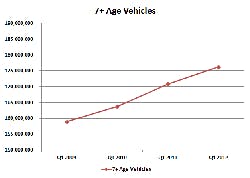Recently, I was watching coverage of the post-IPO Facebook plunge and saw that Wall Street’s latest shiny object was down about 30 percent from its opening price. While it’s too early to tell what will become of Facebook, the news got me thinking about what makes a company truly valuable. Although the automotive aftermarket isn’t filled with high-profile, new-economy companies, there are many organizations that provide a great value — namely, keeping our cars and trucks on the road. When I reflect on some of the aftermarket industry’s key statistics, they point to several potentially rewarding years ahead.
There are several trends converging to enhance the future for the aftermarket. First, the pool of vehicles seven years or older will grow significantly in the next two years. Model years 2007 to 2008 were high-volume sales years, and many of these vehicles will need various repairs over the next few years. Second, scrappage rates have been much lower in recent years. Third, orphaned brands such as Pontiac, Saturn, Hummer, Mercury, Oldsmobile, Plymouth, Isuzu and Geo encompass 6.9 percent of U.S. vehicles currently in operation.
Current vehicles in operation for model years 2007 and 2008 total 15.1 million and 14 million, respectively. By 2014, most of these vehicles will be more than seven years old and will be prime targets for replacement aftermarket parts. Combined with lower scrappage rates over the past few years and higher vehicle longevity, the average age for all light duty vehicles in the U.S. vehicle market was up 1.9 percent in Q1 2012 from the same time last year. The average age is 11 years for both passenger cars and light trucks.
As of Q1 2012, there were nearly 17.3 million more vehicles in the seven years and older category compared with Q1 2009, and this number will continue to grow based on the strength of the 2007 to 2008 model years. As the vehicle population ages, the aftermarket should continue to see an uptick in business.
However, this uptick won’t be realized if automotive aftermarket organizations don’t do a good job of analyzing vehicles in operation data to make sure they are making the right parts stocking decisions.
For example, while electric vehicles and hybrids tend to generate a significant amount of media attention, aftermarket organizations will need to look closely at what is really happening in the marketplace, as they represent only 0.9 percent of the U.S. market. While these vehicles could become consumer favorites someday, their impact on the aftermarket won’t be felt in the foreseeable future. Light trucks continue to grow in popularity, encompassing 50.8 percent of vehicles on the road in Q1 2012. This number is up from 50.4 percent during the same period last year in the United States.
In addition, today’s top four selling models in the United States are the Ford F-150, Honda Accord, Toyota Camry and Chevrolet Silverado. With trucks occupying two of the top four spots, aftermarket organizations will have to plan accordingly to meet the service and parts needs in this segment for years to come.
There is no question that opportunities exist for aftermarket organizations to succeed in the near future. The key will be truly understanding what is happening in the marketplace and getting the fastest, most reliable data available for decision making. If aftermarket organizations do this, then they’ll avoid making a drastic plunge like the gang at Facebook.



